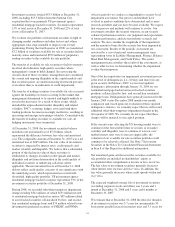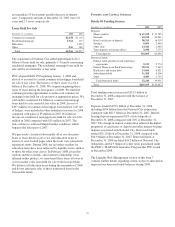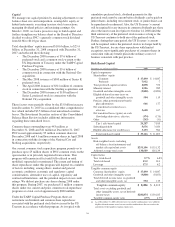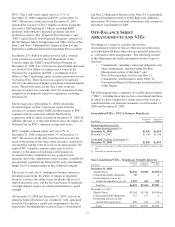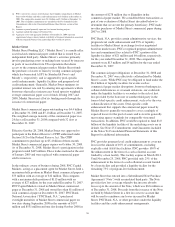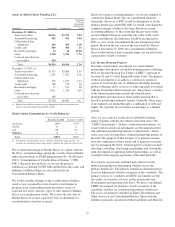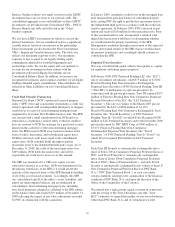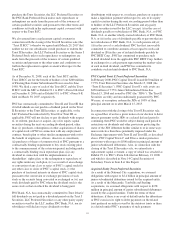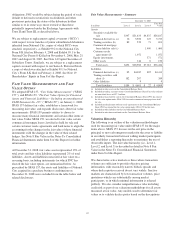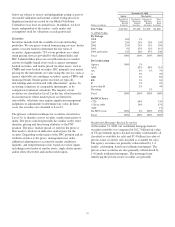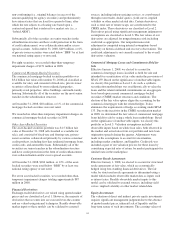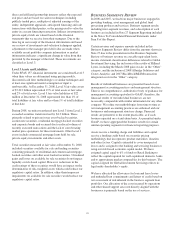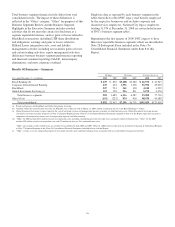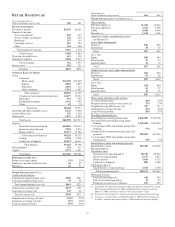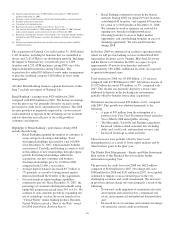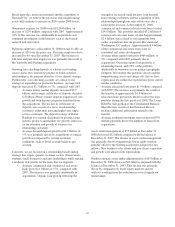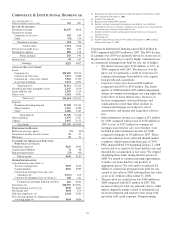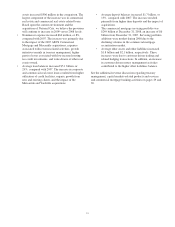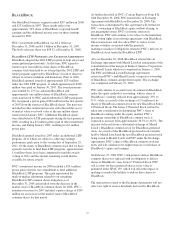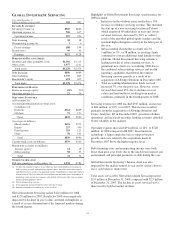PNC Bank 2008 Annual Report Download - page 48
Download and view the complete annual report
Please find page 48 of the 2008 PNC Bank annual report below. You can navigate through the pages in the report by either clicking on the pages listed below, or by using the keyword search tool below to find specific information within the annual report.
non-conforming (i.e., original balances in excess of the
amount qualifying for agency securities) and predominately
have interest rates that are fixed for a period of time, after
which the rate adjusts to a floating rate based upon a
contractual spread that is indexed to a market rate (i.e., a
“hybrid ARM”).
Substantially all of the securities are senior tranches in the
subordination structure and have credit protection in the form
of credit enhancement, over-collateralization and/or excess
spread accounts. At December 31, 2008, $419 million, or 6%,
of private-issuer securities were rated below “BBB” by at least
one national rating agency or not rated.
For eight securities, we recorded other-than-temporary
impairment charges of $151 million in 2008.
Commercial Mortgage-Backed Securities
The commercial mortgage-backed securities portfolio was
$3.4 billion fair value at December 31, 2008 (all classified as
available for sale), and consisted of fixed-rate, private-issuer
securities collateralized by non-residential properties,
primarily retail properties, office buildings, and multi-family
housing. Substantially all of the securities are the most senior
tranches in the subordination structure.
At December 31, 2008, $18 million, or 1%, of the commercial
mortgage-backed securities were not rated.
We recorded no other-than-temporary impairment charges on
commercial mortgage-backed securities in 2008.
Other Asset-Backed Securities
The asset-backed securities portfolio was $1.5 billion fair
value at December 31, 2008 (all classified as available for
sale), and consisted of fixed-rate and floating-rate, private-
issuer securities collateralized primarily by various consumer
credit products, including first-lien residential mortgage loans,
credit cards, and automobile loans. Substantially all of the
securities are senior tranches in the subordination structure
and have credit protection in the form of credit enhancement,
over-collateralization and/or excess spread accounts.
At December 31, 2008, $184 million, or 12%, of the asset-
backed securities were rated below “BBB” by at least one
national rating agency or not rated.
For seven asset-backed securities, we recorded other-than-
temporary impairment charges totaling approximately $87
million in 2008.
Financial Derivatives
Exchange-traded derivatives are valued using quoted market
prices and are classified as Level 1. However, the majority of
derivatives that we enter into are executed over-the-counter
and are valued using internal techniques. Readily observable
market inputs to these models can be validated to external
sources, including industry pricing services, or corroborated
through recent trades, dealer quotes, yield curves, implied
volatility or other market related data. Certain derivatives,
such as total rate of return swaps, are corroborated to the
CMBX index. These derivatives are classified as Level 2.
Derivatives priced using significant management judgment or
assumptions are classified as Level 3. The fair values of our
derivatives are adjusted for nonperformance risk including
credit risk as appropriate. Our nonperformance risk
adjustment is computed using internal assumptions based
primarily on historical default and recovery observations. The
credit risk adjustment is not currently material to the overall
derivatives valuation.
Commercial Mortgage Loans and Commitments Held for
Sale
Effective January 1, 2008, we elected to account for
commercial mortgage loans classified as held for sale and
intended for securitization at fair value under the provisions of
SFAS 159. Based on the significance of unobservable inputs,
we classify this portfolio as Level 3. As such, a synthetic
securitization methodology was used historically to value the
loans and the related unfunded commitments on an aggregate
basis based upon current commercial mortgage-backed
securities (CMBS) market structures and conditions. The
election of the fair value option aligns the accounting for the
commercial mortgages with the related hedges. It also
eliminates the requirements of hedge accounting under SFAS
133. Due to the inactivity in the CMBS securitization market
in 2008, we determined the fair value of commercial mortgage
loans held for sale by using a whole loan methodology. Based
on the significance of unobservable inputs, we classify this
portfolio as Level 3. Valuation assumptions included
observable inputs based on whole loan sales, both observed in
the market and actual sales from our portfolio and new loan
origination spreads during the quarter. Adjustments were
made to the assumptions to account for uncertainties,
including market conditions, and liquidity. Credit risk was
included as part of our valuation process for these loans by
considering expected rates of return for market participants for
similar loans in the marketplace.
Customer Resale Agreements
Effective January 1, 2008, we elected to account for structured
resale agreements at fair value, which are economically
hedged using free-standing financial derivatives. The fair
value for structured resale agreements is determined using a
model which includes observable market data as inputs such
as interest rates. Readily observable market inputs to this
model can be validated to external sources, including yield
curves, implied volatility or other market related data.
Equity Investments
The valuation of direct and indirect private equity investments
requires significant management judgment due to the absence
of quoted market prices, inherent lack of liquidity and the
long-term nature of such investments. The carrying values of
44


